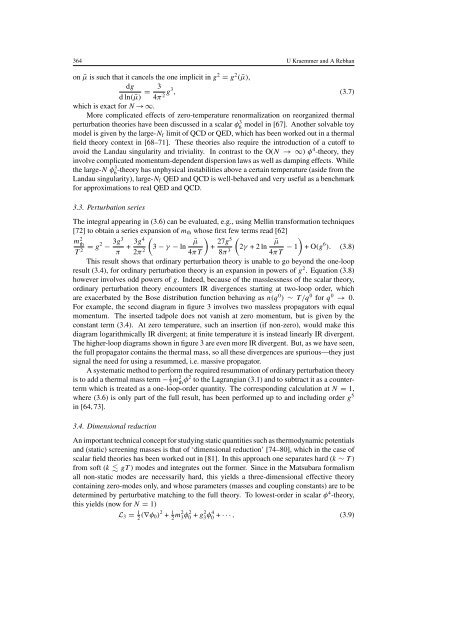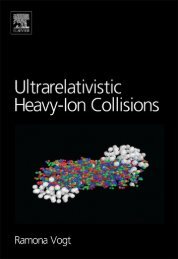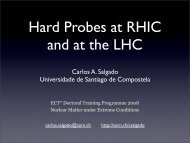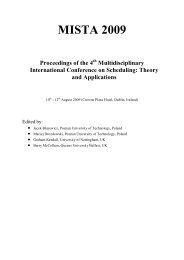Advances in perturbative thermal field theory - Ultra-relativistic ...
Advances in perturbative thermal field theory - Ultra-relativistic ...
Advances in perturbative thermal field theory - Ultra-relativistic ...
Create successful ePaper yourself
Turn your PDF publications into a flip-book with our unique Google optimized e-Paper software.
364 U Kraemmer and A Rebhan<br />
on ¯µ is such that it cancels the one implicit <strong>in</strong> g 2 = g 2 ( ¯µ),<br />
dg<br />
dln( ¯µ) = 3<br />
4π 2 g3 , (3.7)<br />
which is exact for N →∞.<br />
More complicated effects of zero-temperature renormalization on reorganized <strong>thermal</strong><br />
perturbation theories have been discussed <strong>in</strong> a scalar φ6 3 model <strong>in</strong> [67]. Another solvable toy<br />
model is given by the large-N f limit of QCD or QED, which has been worked out <strong>in</strong> a <strong>thermal</strong><br />
<strong>field</strong> <strong>theory</strong> context <strong>in</strong> [68–71]. These theories also require the <strong>in</strong>troduction of a cutoff to<br />
avoid the Landau s<strong>in</strong>gularity and triviality. In contrast to the O(N →∞) φ 4 -<strong>theory</strong>, they<br />
<strong>in</strong>volve complicated momentum-dependent dispersion laws as well as damp<strong>in</strong>g effects. While<br />
the large-N φ6 3 -<strong>theory</strong> has unphysical <strong>in</strong>stabilities above a certa<strong>in</strong> temperature (aside from the<br />
Landau s<strong>in</strong>gularity), large-N f QED and QCD is well-behaved and very useful as a benchmark<br />
for approximations to real QED and QCD.<br />
3.3. Perturbation series<br />
The <strong>in</strong>tegral appear<strong>in</strong>g <strong>in</strong> (3.6) can be evaluated, e.g., us<strong>in</strong>g Mell<strong>in</strong> transformation techniques<br />
[72] to obta<strong>in</strong> a series expansion of m th whose first few terms read [62]<br />
m 2 (<br />
) (<br />
)<br />
th<br />
T = 2 g2 − 3g3<br />
π<br />
+ 3g4<br />
¯µ<br />
3 − γ − ln + 27g5<br />
¯µ<br />
2γ +2ln<br />
2π 2 4πT 8π 3 4πT − 1 +O(g 6 ). (3.8)<br />
This result shows that ord<strong>in</strong>ary perturbation <strong>theory</strong> is unable to go beyond the one-loop<br />
result (3.4), for ord<strong>in</strong>ary perturbation <strong>theory</strong> is an expansion <strong>in</strong> powers of g 2 . Equation (3.8)<br />
however <strong>in</strong>volves odd powers of g. Indeed, because of the masslessness of the scalar <strong>theory</strong>,<br />
ord<strong>in</strong>ary perturbation <strong>theory</strong> encounters IR divergences start<strong>in</strong>g at two-loop order, which<br />
are exacerbated by the Bose distribution function behav<strong>in</strong>g as n(q 0 ) ∼ T/q 0 for q 0 → 0.<br />
For example, the second diagram <strong>in</strong> figure 3 <strong>in</strong>volves two massless propagators with equal<br />
momentum. The <strong>in</strong>serted tadpole does not vanish at zero momentum, but is given by the<br />
constant term (3.4). At zero temperature, such an <strong>in</strong>sertion (if non-zero), would make this<br />
diagram logarithmically IR divergent; at f<strong>in</strong>ite temperature it is <strong>in</strong>stead l<strong>in</strong>early IR divergent.<br />
The higher-loop diagrams shown <strong>in</strong> figure 3 are even more IR divergent. But, as we have seen,<br />
the full propagator conta<strong>in</strong>s the <strong>thermal</strong> mass, so all these divergences are spurious—they just<br />
signal the need for us<strong>in</strong>g a resummed, i.e. massive propagator.<br />
A systematic method to perform the required resummation of ord<strong>in</strong>ary perturbation <strong>theory</strong><br />
is to add a <strong>thermal</strong> mass term − 1 2 m2 th φ2 to the Lagrangian (3.1) and to subtract it as a counterterm<br />
which is treated as a one-loop-order quantity. The correspond<strong>in</strong>g calculation at N = 1,<br />
where (3.6) is only part of the full result, has been performed up to and <strong>in</strong>clud<strong>in</strong>g order g 5<br />
<strong>in</strong> [64, 73].<br />
3.4. Dimensional reduction<br />
An important technical concept for study<strong>in</strong>g static quantities such as thermodynamic potentials<br />
and (static) screen<strong>in</strong>g masses is that of ‘dimensional reduction’ [74–80], which <strong>in</strong> the case of<br />
scalar <strong>field</strong> theories has been worked out <strong>in</strong> [81]. In this approach one separates hard (k ∼ T )<br />
from soft (k gT ) modes and <strong>in</strong>tegrates out the former. S<strong>in</strong>ce <strong>in</strong> the Matsubara formalism<br />
all non-static modes are necessarily hard, this yields a three-dimensional effective <strong>theory</strong><br />
conta<strong>in</strong><strong>in</strong>g zero-modes only, and whose parameters (masses and coupl<strong>in</strong>g constants) are to be<br />
determ<strong>in</strong>ed by <strong>perturbative</strong> match<strong>in</strong>g to the full <strong>theory</strong>. To lowest-order <strong>in</strong> scalar φ 4 -<strong>theory</strong>,<br />
this yields (now for N = 1)<br />
L 3 = 1 2 (∇φ 0) 2 + 1 2 m2 3 φ2 0 + g2 3 φ4 0 + ···, (3.9)







